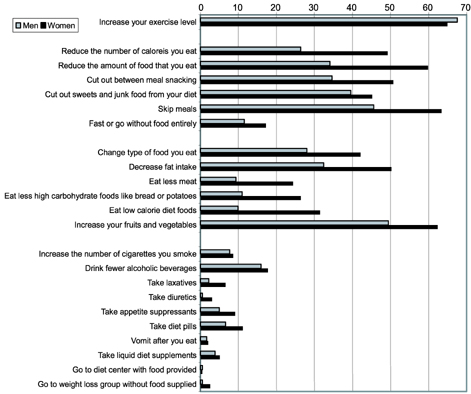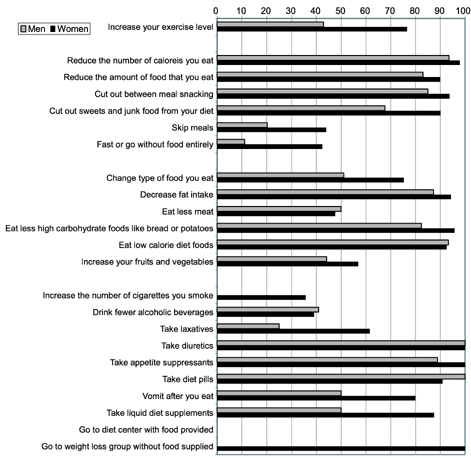Nutr Res Pract.
2007 Sep;1(3):218-223.
Identification of weight-control behaviors practiced by diverse groups of college students
- Affiliations
-
- 1Healthy City Team, Division of Health Promotion, Seoul Metropolitan Government, Seoul 100-739, Korea.
- 2Department of Nutritional Sciences, Rutgers, The State University of New Jersey, 26 Nichol Ave. New Brunswick, NJ 08901, USA. keenan@aesop.rutgers.edu
- 3Department of Food Science & Nutrition, Pusan National University, KyungNam 627-706, Korea.
Abstract
- This study investigated: 1) what weight-related behaviors college students practiced; 2) if the behaviors were performed for weight-related reasons; and 3) whether the behavioral practices differed by gender, race, and body weight status. This cross-sectional study used a questionnaire to collect information from a non-probability sample of undergraduate students (n=379; 48% men) recruited from large introductory psychology classes. Chi-square tests were conducted to examine simple comparisons, and multiple logistic regression analyses assessed differences. Male students reported adopting significantly fewer weight-related behaviors than females. Most frequently males increased exercise (69.2%), increased fruit and vegetable consumption (50%), skipped meals (46%), cut out sweets and junk foods (40%), and cut out between-meal snacks (35%). Female students most frequently increased exercise (67.4%), skipped meals (63%), increased fruit and vegetable consumption (62%), reduced the amount of food eaten (60%), and cut out between-meal snacks (51%). Negative behaviors were engaged in by only a few participants. Weight-related reasons were a significant factor for weight-related behavior adoption. Multiple logistic regression analyses showed that gender was consistently and significantly associated with the adoption of weight-related behaviors, while race and weight status were less consistently associated. Findings of this study will be helpful to dietitians who counsel college students. Results of this study may support efforts to bring more comprehensive behaviorally-focused health and nutrition interventions to college campuses.
Keyword
MeSH Terms
Figure
Reference
-
1. Breitkopf CR, Berenson AB. Correlates of weight loss behaviors among low-income African-American, Caucasian, and Latina women. Obstet Gynecol. 2004. 103:231–239.
Article2. Butler SM, Black DR, Blue CL, Gretebeck RJ. Change in diet, physical activity, and body weight in female college freshman. Am J Health Behav. 2004. 28:24–32.
Article3. Center for Disease Control and Prevention. Update: prevalence of overweight among children, adolescents, and adults-United States, 1998-1994. MMWR Morb Mortal Wkly Rep. 1997a. 46:199–202.4. Center for Disease Control and Prevention. Youth Risk Behavior Surveillance: National College Health Risk Behavior Survey-United States, 1995. MMWR Morb Mortal Wkly Rep. 1997b. 46:1–54.5. Center for Disease Control and Prevention. Prevalence ofPhysical Activity, Including Lifestyle Activities Among Adults - United States, 2000-2001. MMWR Morb Mortal Wkly Rep. 2003. 52:764–769.6. George VA, Johnson P. Weight loss behaviors and smoking in college students of diverse ethnicity. Am J Health Behav. 2001. 25:115–124.
Article7. Gibson R. Principles of nutritional assessment. 1990. New York. USA: Oxford University Press.8. Graham MA, Jones AL. Freshman 15: Valid Theory or Harmful Myth? J Am Coll Health. 2002. 50:171–173.
Article9. Healthy People 2010. 2000. 2nd ed. Washington DC. USA: US Department of Health and Human Services.10. Hedley AA, Ogden CL, Johnson CL, Carroll MD, Curtin LR, Flegal KM. Prevalence of overweight and obesity among US children, adolescents, and adults. JAMA. 2004. 291:2847–2850.
Article11. Hoffman DJ, Policastro P, Quick V, Lee SK. Changes in body weight and fat mass of men and women in the first year of college: A study of the "Freshman Fifteen". J Am Colle Health. 2006. 55:41–46.
Article12. Hovell MF, Mewborn CR, Randle Y, Fowler-Johnson S. Risk of excess weight gain in university women: a three-year community controlled analysis. Addict Behav. 1985. 10:15–28.
Article13. Huang TT, Harris KJ, Lee RE, Nazir N, Born W, Kaur H. Assessing overweight, obesity, diet, and physical activity in college students. J Am Coll Health. 2003. 52:83–86.
Article14. July F, Hawthorne D, Elliot J, Robinson W. Weight management behaviors of African American female college students. ABNF J. 2003. 14:71–72. [Abstract].15. Lowry R, Galuska DA, Fulton JE, Wechsler H, Kann L, Collins JL. Physical activity, food choice, and weight management goals and practices among U.S. College students. Am J Prev Med. 2000. 18:18–27.
Article16. McKinley NM. Sobal J, Maurer D, editors. Ideal weight/ideal women. Weighty Issues: Fatness and thinness as social problems. 1999. New York. USA: Aldine de Gruyter;97–115.
Article17. National Cancer Insititute. Monograph: 5 a day for better health program. Issued September 2001. 2004. Accessed on 7/13/2004. Available at http://www.5aday.gov/pdf/masimaxmonograph.pdf.18. Office of the Surgeon General. The Surgeon General's Call to Action to Prevent and Decrease Overweight and Obesity. 2001. Rockville, MD. USA: Public Health Service.19. US Census Bureau: School Enrollment. 2000 Census Brief. Issued August 2003. 2004. Accessed on 7/13/2004. Available at http://www.census.gov/prod/2001pubs/c2kbr01-12.pdf.20. World Health Organization. Physical status: The use and interpretation of anthropometry. WHO Technical Report Series. 1995. Geneva. Switzerland: World Health Organization.
- Full Text Links
- Actions
-
Cited
- CITED
-
- Close
- Share
- Similar articles
-
- Weight Control Behaviors in Female College Students
- The BMI, Body Image Recognition, and Weight Control Behavior of Female College Students
- Weight-related Perceptions, Practices and Eating Behaviors of Middle School Students: Associations with BMI
- A Study on nutrition Knowledge, Nutritional Attitudes, Dietary Behavior and Dietary Intake by Weight Control Attempt among Middle School Female Students
- Factors affecting Body Weight Control Behavior of Female College Students



